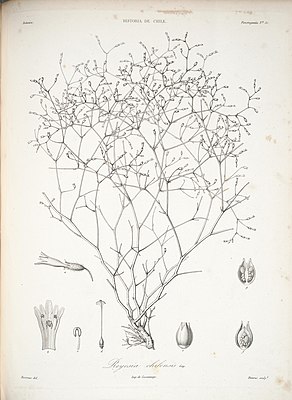Reyesia
| Reyesia | ||||||||||||
|---|---|---|---|---|---|---|---|---|---|---|---|---|

|
||||||||||||
| Systematics | ||||||||||||
|
||||||||||||
| Scientific name | ||||||||||||
| Reyesia | ||||||||||||
| Gay |
Reyesia is a plant genus of the family of the nightshade family (Solanaceae). It is named in honor of the Chilean lawyer, politician, publicist and botanist Antonio Garcia Reyes (1817–1855). The four species occur in northern Chile as far as Argentina .
description
Vegetative characteristics
Reyesia are upright, rarely 12, usually 30 to 80 centimeters high, heavily branched or sticky plants that grow with a main stem. They are persistent (or possibly two years) or annual. The internodes can be short or long, tender or robust and firm.
One species has almost no leaves and its terminal branches are spiky. The lower leaves of other species have large, elliptical leaf blades with a length of 20 to 40 (to 70) mm, which are feathery split or curved and run down on the conspicuous 12 to 40 mm long petioles . A basal rosette can also be formed, with the broad leaves on long petioles. At higher nodes , the leaf stalks are then shorter or may be absent, the leaf blades are smaller and scale-shaped or inconspicuous, the uppermost ones are transformed into thread-like, linear scales (1 to) 3 to 20 mm long and 1 mm wide.
Flowers and inflorescences
The flowers are single and terminal. They are small, the flower stalk is (3 to) 10 to 20 mm long. The calyx is radially symmetrical, 2 to 4 mm long and, like the peduncle, strongly glandular. It is set with five short, uniform, pointed teeth. The crown is zygomorphic , 6 to 13 (to 15) mm long, tubular or funnel-shaped, purple, blue or yellow in color and can be provided with purple stripes. The coronet consists of five corolla lobes, of which the upper one is slightly larger. The lobes are shorter than the corolla tube, the reproductive organs are enclosed by the corolla and slightly bent towards the upper corolla lobe.
The four stamens come in two forms. The rear pair of stamens has larger anthers with a length of 0.8 to 1 mm. The front pair of stamens can be fertile ( e.g. Reyesia chilensis ) or sterile ( e.g. Reyesia parviflora ). The stamens are hairless or hairy, the two counters of the anthers are usually unequal, the stamens start at the base of the anthers. The pollen grains are poured out individually or in tetrads. The nectaries are pillow-shaped and bilobed. The stylus is thread-shaped and can be hollow. It is almost as long as the longest stamens, its end is spoon-shaped.
Fruits and seeds
The fruits are 2.9 to 4.4 mm long capsules that contain (rarely just two or three) twelve to 14 (rarely 20 to 25) seeds . The capsules are hidden at the bottom of the permanent chalice. The episperm of the seeds is reticulated or granular, the embryo is tortuous.
Occurrence and locations
The species of the genus Reyesia occur in the Andes of northern Chile . Only the range of Reyesia parviflora extends into the Argentine part of the Andes.
The plants usually grow as xerophytes at altitudes between 2900 and 3500 m, only Reyesia chilensis grows between 200 and 800 m.
Systematics
Four species are distinguished within the genus.
- Reyesia chilensis Gay
- Reyesia juniperoides (Werderm.) D'Arcy
- Reyesia laxa (Miers) D'Arcy
- Reyesia parviflora (Phil.) Hunz.
proof
literature
- Armando T. Hunziker: The Genera of Solanaceae . ARG Gantner Verlag KG, Ruggell, Liechtenstein 2001. ISBN 3-904144-77-4 .
Individual evidence
- ↑ Lotte Burkhardt: Directory of eponymous plant names . Extended Edition. Botanic Garden and Botanical Museum Berlin, Free University Berlin Berlin 2018. [1]
- ^ William D'Arcy: A Preliminary Synopsis of Salpiglossis and Other Cestreae (Solanaceae) . In: Annals of the Missouri Botanical Garden , Volume 65, 1978. pp. 698-724.